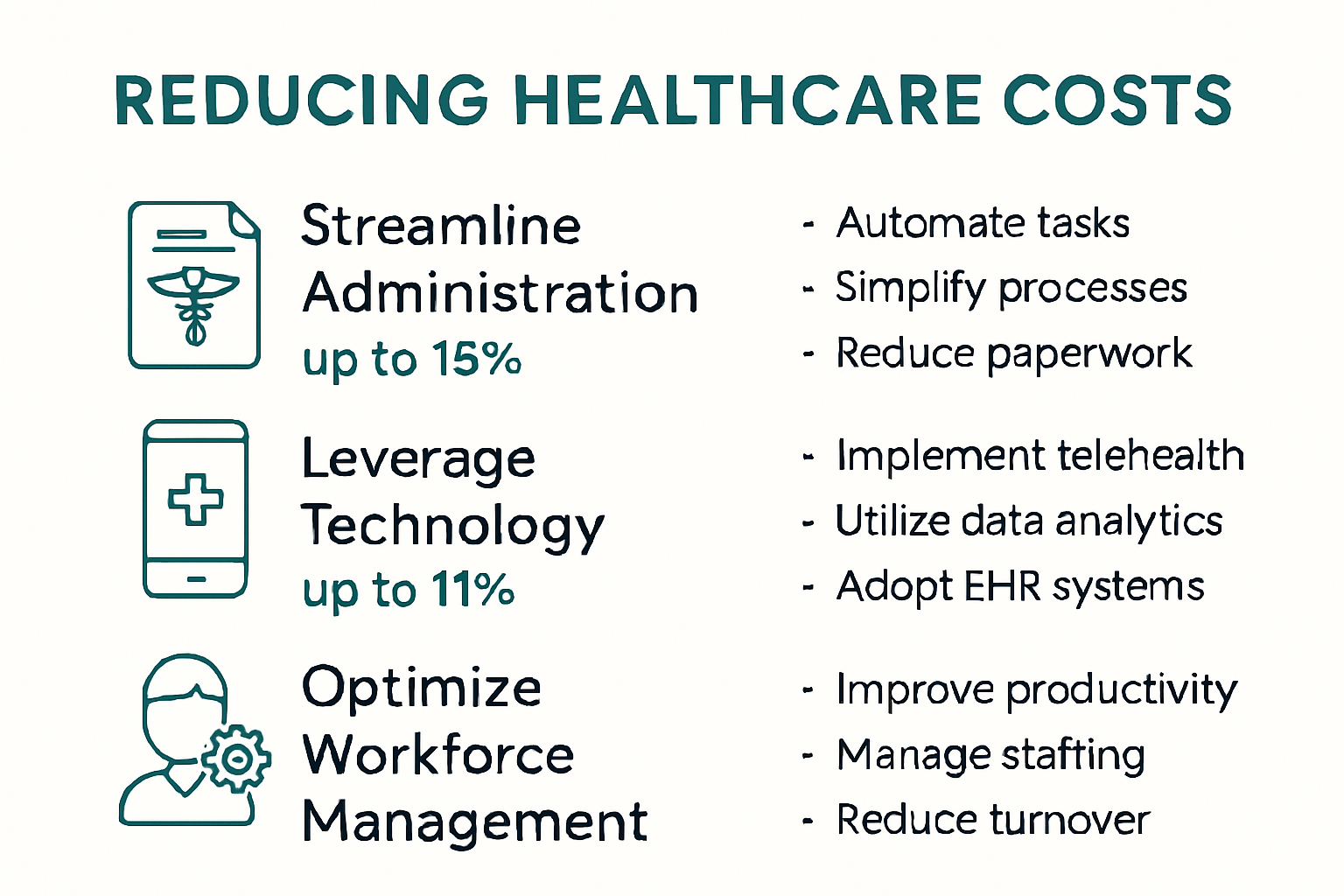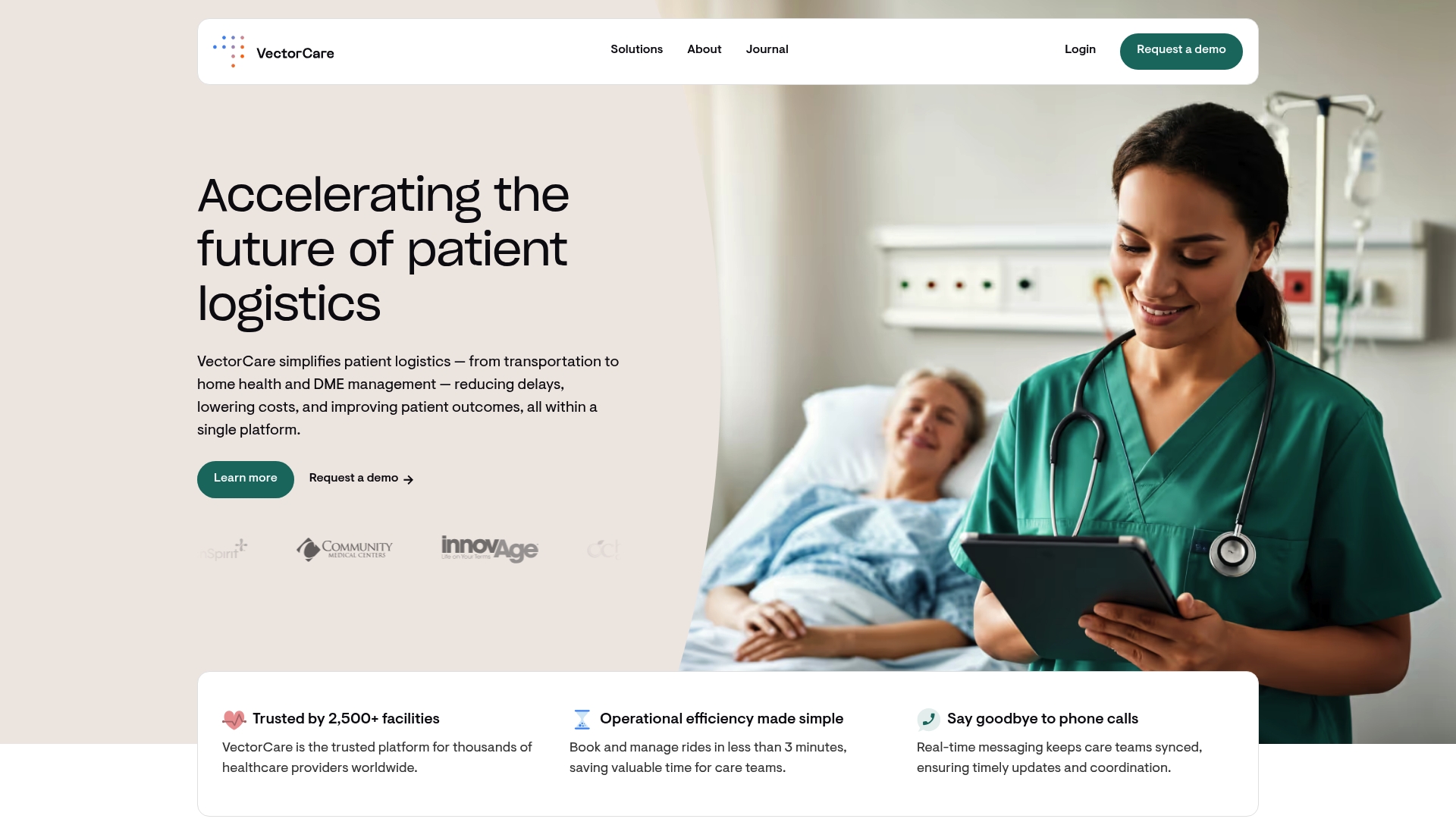How to Reduce Operational Costs in Healthcare Organizations

Healthcare costs are rising faster than ever and experts estimate that administrative expenses now make up about 25 percent of all healthcare spending in the United States. That’s more than the average family spends on housing or groceries each year. You might think cutting these costs means slashing jobs or sacrificing quality care but technology and smarter partnerships are actually unlocking ways to save billions without sacrificing patient outcomes. The most dramatic savings are hiding in the places no one expects and they start where administration, workforce, and innovation collide.
Table of Contents
- Streamlining Administrative And Billing Processes
- Leveraging Technology To Cut Expenses
- Optimizing Workforce And Resource Management
- Partnering And Outsourcing For Cost Savings
Quick Summary
| Takeaway | Explanation |
|---|---|
| Automate administrative tasks | Implementing automated documentation and billing systems can drastically reduce operational costs and errors. |
| Leverage AI for cost savings | Utilize AI and predictive analytics to enhance efficiency and identify cost-reduction opportunities within operational processes. |
| Optimize workforce management | Adopting flexible staffing strategies and cross-training employees can significantly decrease labor costs while maintaining care quality. |
| Outsource non-core services | Outsourcing specific administrative functions can free up resources and focus on core patient care activities to save costs. |
| Create strategic technology partnerships | Establish partnerships with technology providers to access innovative solutions and reduce internal implementation costs. |

Streamlining Administrative and Billing Processes
Healthcare organizations face significant financial challenges due to inefficient administrative and billing processes. The complexity of medical billing and administrative workflows directly impacts operational costs, with manual processes consuming substantial resources and creating unnecessary financial strain.
Reducing Manual Documentation Burdens
Administrative overhead in healthcare is a massive economic challenge. Research from JAMA Network reveals that administrative costs account for approximately 25% of total healthcare spending in the United States. These costs stem from complex documentation requirements, manual data entry, and inefficient billing cycles that consume valuable staff time and organizational resources.
Healthcare providers can significantly reduce operational costs by implementing automated documentation systems. Electronic health record (EHR) integration and automated billing platforms can dramatically decrease manual data processing time. By minimizing redundant paperwork and streamlining information management, organizations can redirect staff energy toward patient care and strategic initiatives.
Implementing Technology-Driven Billing Solutions
Modern healthcare requires sophisticated technological approaches to administrative processes. Becker’s Hospital Review highlights that technology-driven billing solutions can reduce administrative expenses by up to 30%. Advanced software platforms enable real-time claims processing, automated error checking, and streamlined reimbursement workflows.
Key strategies for reducing administrative costs include:
To clarify the main strategies discussed in improving administrative and billing efficiency, here’s a summary table of key approaches and their potential impacts on cost reduction:
| Strategy | How It Reduces Costs |
|---|---|
| Automated Documentation Systems | Decreases manual entry time and reduces administrative overhead |
| Automated Claims Processing | Lowers staff workload and speeds up billing cycles |
| AI-Powered Billing Validation | Cuts claim errors, reducing rejected claims and rework |
| Integrated Payment Systems | Simplifies payments and reduces manual reconciliation steps |
- Automated Claims Processing: Implement systems that automatically verify insurance eligibility and submit claims
- AI-Powered Billing Validation: Use machine learning algorithms to detect potential billing errors before submission
- Integrated Payment Systems: Create seamless digital payment experiences that reduce manual reconciliation
Optimizing Workflow Efficiency
Healthcare organizations must view administrative processes as strategic opportunities for cost reduction. By investing in smart technologies and workflow optimization, providers can transform administrative departments from cost centers into efficiency engines. This approach not only reduces operational expenses but also improves overall organizational performance.
The goal is not merely to cut costs but to create more intelligent, responsive administrative systems that support high-quality patient care. Learn more about how our technology empowers healthcare professionals in reimagining administrative workflows.
By embracing digital transformation and strategic process redesign, healthcare organizations can substantially reduce administrative costs while maintaining exceptional standards of patient service and operational excellence.
Leveraging Technology to Cut Expenses
Healthcare organizations are increasingly turning to advanced technologies as strategic solutions for reducing operational expenses and improving overall efficiency. The digital transformation of healthcare delivery presents unprecedented opportunities to optimize resource allocation and minimize unnecessary costs.
Artificial Intelligence and Predictive Analytics
Research from the National Institutes of Health demonstrates that health information technology can significantly reduce operating expenses by improving administrative efficiency and minimizing resource waste. Artificial intelligence (AI) and predictive analytics are emerging as powerful tools for cost management, enabling healthcare providers to make data-driven decisions that streamline operations.
AI-powered solutions can analyze complex healthcare data patterns, helping organizations predict patient needs, optimize staffing levels, and reduce unnecessary medical interventions. Machine learning algorithms can identify potential cost-saving opportunities by analyzing historical treatment patterns, resource utilization, and patient outcomes. These technological approaches transform raw data into actionable insights that directly impact an organization’s financial performance.
Telehealth and Remote Monitoring Technologies
The International Journal of Medical Informatics highlights how technology-driven process optimization can lower operational costs by reducing unnecessary hospitalizations and enabling more effective patient management. Telehealth and remote monitoring technologies have emerged as critical tools for cost reduction, allowing healthcare providers to deliver high-quality care while minimizing physical infrastructure expenses.
Key technological strategies for expense reduction include:
- Virtual Consultation Platforms: Reduce overhead costs associated with physical consultations
- Remote Patient Monitoring: Decrease hospital readmission rates and emergency interventions
- Digital Health Tracking: Enable proactive health management and early intervention
Integrated Technology Ecosystems
Successful cost reduction requires a holistic approach to technological integration. Healthcare organizations must develop comprehensive technology ecosystems that communicate seamlessly across different departments and systems. Explore how our technology empowers healthcare professionals in creating more efficient operational frameworks.
By strategically implementing advanced technologies, healthcare providers can transform traditional cost centers into dynamic, intelligent systems that deliver exceptional patient care while maintaining financial sustainability. The future of healthcare lies in embracing digital innovation as a fundamental approach to operational excellence and cost management.
Technology is not merely a tool but a strategic partner in reimagining healthcare delivery, offering unprecedented opportunities to reduce expenses, improve patient outcomes, and create more responsive, efficient healthcare systems.
Optimizing Workforce and Resource Management
Healthcare organizations face complex challenges in managing workforce expenses and maximizing resource utilization. Strategic approaches to workforce management can significantly reduce operational costs while maintaining high-quality patient care and organizational effectiveness.
Strategic Workforce Deployment
Research from Oliver Wyman reveals a transformative approach to healthcare staffing. By increasing the ratio of advanced practice providers (APPs) to primary care physicians from 0.5:1 to 2.5:1, organizations can potentially expand patient panel sizes by over 600 patients and save nearly $60 billion in labor costs by 2035.
Workforce optimization requires a nuanced approach that goes beyond traditional staffing models. Healthcare leaders must develop flexible staffing strategies that balance clinical expertise, patient needs, and cost-effectiveness. This includes cross-training staff, implementing more efficient scheduling systems, and creating career development pathways that retain top talent.
Reducing Labor Cost Inefficiencies
HealthManagement.org emphasizes the critical importance of reassessing hiring practices and workforce management strategies. Key approaches to reducing labor costs include:
- Talent Alignment: Recruit professionals whose skills precisely match organizational needs
- Reducing Contract Labor: Minimize reliance on expensive temporary staffing
- Workforce Development: Invest in training programs that enhance employee skills and retention
By addressing workforce challenges proactively, healthcare organizations can create more stable, efficient, and cost-effective staffing models that directly impact operational expenses.
Technology-Enabled Resource Management
NetSuite highlights that automation and intelligent resource management can dramatically reduce operational costs. Implementing advanced technologies allows healthcare organizations to streamline routine tasks, optimize data management, and eliminate manual work.
Resource management technologies enable more precise tracking of staff utilization, patient needs, and operational requirements. Learn more about how our technology empowers healthcare professionals in creating more efficient workforce strategies.

The future of healthcare workforce management lies in creating intelligent, adaptive systems that balance human expertise with technological innovation. By embracing strategic approaches to workforce optimization, healthcare organizations can significantly reduce operational costs while maintaining exceptional patient care and organizational resilience.
Partnering and Outsourcing for Cost Savings
Healthcare organizations increasingly recognize strategic partnerships and targeted outsourcing as powerful mechanisms for reducing operational costs while maintaining high-quality service delivery. By carefully selecting external collaborations, healthcare providers can streamline operations, access specialized expertise, and achieve significant financial efficiencies.
Strategic Service Outsourcing
Research from the International Journal of Health Policy and Management reveals that strategic outsourcing of non-core services can substantially reduce organizational expenses. Selective outsourcing allows healthcare organizations to focus on core medical services while leveraging external partners’ specialized capabilities and cost-effective solutions.
Critical areas for potential outsourcing include administrative services, medical billing, laboratory services, diagnostic imaging, facility management, and support infrastructure. By identifying non-essential functions that can be more efficiently managed externally, healthcare organizations can redirect internal resources toward patient care and strategic initiatives.
The following table summarizes essential areas for potential outsourcing, as described in the article, and their associated cost-saving benefits for healthcare organizations:
| Outsourced Service Area | Cost-Saving Benefit |
|---|---|
| Administrative Services | Frees up internal resources for core patient care |
| Medical Billing | Reduces operational complexity and billing errors |
| Laboratory Services | Eliminates need for in-house expensive equipment |
| Diagnostic Imaging | Access to specialized skills without capital expense |
| Facility Management | Lowers ongoing maintenance and staffing costs |
| Support Infrastructure | Optimizes operations and reduces non-core expenses |
Collaborative Technology Partnerships
Advanced technology partnerships offer healthcare organizations unprecedented opportunities to reduce operational costs. Collaborating with specialized technology providers enables access to cutting-edge solutions without significant internal investment. These partnerships can help organizations implement sophisticated systems for patient management, administrative processing, and resource optimization.
Key considerations for effective technology partnerships include:
- Scalable Solutions: Choose partners offering flexible, adaptable technological platforms
- Compliance Alignment: Ensure external partners meet stringent healthcare regulatory requirements
- Integration Capabilities: Select technologies that seamlessly connect with existing organizational systems
Network and Resource Sharing
Healthcare organizations can achieve substantial cost savings by developing collaborative networks that share resources, expertise, and infrastructure. Learn more about how coordinated platforms can unite private and public interests to support more efficient healthcare delivery.
Sharing resources across multiple healthcare providers can help distribute fixed costs, reduce redundant investments, and create more efficient operational models. This might include sharing medical equipment, developing joint training programs, or creating regional healthcare networks that optimize resource utilization.
Successful partnerships require careful evaluation, transparent communication, and aligned strategic objectives. Healthcare leaders must approach outsourcing and collaboration as nuanced strategic decisions that balance cost reduction with maintaining exceptional patient care quality.
By embracing intelligent partnership strategies, healthcare organizations can transform traditional cost centers into dynamic, collaborative ecosystems that drive operational efficiency, innovation, and sustainable financial performance.
Frequently Asked Questions
What are effective ways to reduce administrative costs in healthcare?
Implementing automated documentation systems and technology-driven billing solutions can drastically reduce administrative expenses and improve efficiency in healthcare organizations.
How can technology help in cutting operational costs in healthcare?
Leveraging technologies like artificial intelligence for predictive analytics, telehealth solutions, and integrated technology ecosystems can minimize unnecessary costs and optimize resource allocation.
What strategies can healthcare organizations use for workforce management to reduce costs?
Healthcare organizations can utilize strategic workforce deployment, cross-training, flexible staffing strategies, and reducing reliance on contract labor to effectively manage and lower labor costs.
What are some benefits of outsourcing in healthcare?
Outsourcing non-core administrative services provides cost savings, allows for resource reallocation to patient care, and accesses specialized expertise without the need for significant internal investment.
Transform Healthcare Operations with VectorCare’s Digital Platform
Struggling with high administrative costs and complex care coordination, as highlighted in the article? Many healthcare organizations lose valuable resources due to manual workflows, inefficient communication, and outdated processes. VectorCare directly addresses these pain points by bringing together automation, AI-powered scheduling, and real-time patient logistics in one secure, integrated platform. If you are looking to streamline patient transportation, simplify durable medical equipment delivery, or optimize your care transitions, VectorCare has the tools to reduce costs and minimize delays.

Make operational excellence a reality today. Discover how VectorCare helps healthcare providers and agencies boost efficiency, lower spending, and deliver better patient outcomes. See real-world case studies, explore scalability, and experience the power of no-code coordination tools. For a deeper look at how our technology empowers professionals to rethink administrative workflows and resource management, visit how our technology empowers healthcare professionals. Take the next step toward future-ready healthcare operations with VectorCare now.
Recommended
- How Coordinated Platforms Can Unite Private and Public Interests to Support Community Care – VectorCare
- Becker’s Healthcare Report: How VectorCare Solves Communication Gaps in Patient Transfers – VectorCare
- How Technology Can Empower Healthcare Professionals – VectorCare
- Patient Flow Barriers: Impact to Hospital Efficiency and Patient Outcomes – VectorCare



